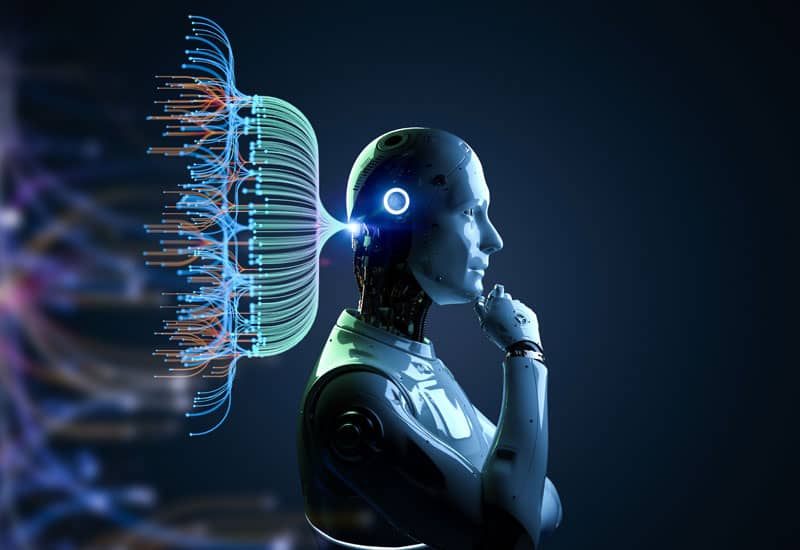Differentiating AI and Machine Learning: A Comprehensive Guide
- Sheharyar Yaqub
- 0 Comments
Differentiating AI and Machine Learning: A Comprehensive Guide
In the fast-moving world of technology today, it’s essential to know the differences between two powerful technologies: Artificial Intelligence (AI) and Machine Learning (ML). While people often use these terms interchangeably, they are actually different areas in the field of computing. In this detailed guide, we’ll look closely at the key distinctions between AI and ML, see where they are used, and understand how they work together in today’s tech world.
What Is AI?
AI, or Artificial Intelligence, is about making machines smart like humans. AI systems can do things that need human thinking, learning, problem-solving, and decision-making. People started thinking about AI in the 1900s. AI can learn, just like people, and it can talk, think, and do tasks based on information. Your phone’s virtual assistant, like Siri or Alexa, is a good example of AI.
What Is Machine Learning?
Machine Learning, often called ML, is a part of AI. It’s all about creating smart programs that learn from data. ML doesn’t need to be told what to do; it learns by itself. In healthcare, it can predict disease outbreaks. In finance, it can catch fraud, and in online shops, it can suggest things based on what you like.
How AI and ML Are Different
AI is the big idea, while ML is one way to make it happen. ML learns from data and doesn’t need lots of rules. AI sometimes follows rules without learning. ML can work more independently once it’s trained, while AI needs more human help. ML is great for things like recommending stuff, while AI can be personal assistants or self-driving cars.
AI and ML Misconceptions
It’s common for people to confuse AI and ML, but they are distinct fields with their own characteristics. Let’s dive into some of the common misconceptions and clarify these points:
- AI and ML are not the same: While AI is the broader concept that aims to replicate human intelligence, ML is a subset of AI focused on learning from data. AI encompasses a wide range of technologies, including expert systems, robotics, and natural language processing, while ML deals specifically with data-driven learning.
- AI is not all-knowing: Contrary to some beliefs, AI is not omnipotent. AI systems have limitations and can only provide information or insights based on the data they’ve been trained on. They don’t possess innate knowledge and can make mistakes.
- AI requires care and updates: AI systems need ongoing maintenance and updates to perform effectively. This is crucial to ensure they remain accurate and up-to-date with changing information. Without regular care, AI systems can become less reliable.
- ML’s autonomy: ML algorithms can work autonomously, meaning they can make predictions or decisions with minimal human intervention once they’ve been trained. However, it’s important to note that their autonomy is limited to the specific tasks they’ve been designed for and the data they’ve learned from.
- Learning from data: ML systems improve their performance as they process more data, but they don’t have the ability to think, reason, or understand like humans. Their learning is focused on the tasks they’ve been trained for, and they lack the general cognitive abilities associated with human intelligence.
By understanding these distinctions and dispelling these misconceptions, we can appreciate the roles of AI and ML more accurately in the ever-evolving landscape of technology.
Where AI and ML Are Used
AI and ML are versatile technologies with a broad range of applications. Here are some key areas where they are making a significant impact:
- Healthcare:
-
- AI and ML assist in disease diagnosis, treatment recommendations, and drug discovery.
- Telemedicine benefits from AI-driven chatbots and virtual assistants.
- Finance:
-
- These technologies support algorithmic trading, fraud detection, and credit scoring.
- AI optimizes portfolio management and risk assessment.
- E-commerce:
-
- AI powers product recommendations and personalization.
- ML aids in inventory management and demand prediction.
- Natural Language Processing (NLP):
-
- Virtual assistants and chatbots use NLP to understand and respond to human language.
- Education:
-
- ML enables personalized learning and automated grading.
- Autonomous Vehicles:
-
- Self-driving cars and drones rely on AI for navigation and real-time decision-making.
These applications showcase the versatility and transformative potential of AI and ML in various industries.

The Future of AI and ML
The future of AI and ML is filled with exciting possibilities and advancements. Here’s a closer look at what we can expect:
-
- AI in Small Devices:
- AI is becoming more compact and efficient. We’ll see AI integrated into smaller devices, including smartphones, IoT gadgets, and wearable technology. These devices will be able to perform tasks with more intelligence and autonomy.
- Ethical AI:
- As AI plays a more significant role in our lives, there will be a growing emphasis on ethical considerations. We’ll witness the development of guidelines and regulations to ensure responsible and ethical AI practices, addressing issues like bias, privacy, and transparency.
- Clear Explanations:
- The “black box” nature of AI, where decisions are made without clear explanations, will be tackled. There will be a focus on making AI systems more transparent, understandable, and accountable. Users will have a better grasp of how AI reaches its conclusions.
- Progress in Machine Learning:
- ML will continue to evolve, with particular advancements in deep learning and reinforcement learning. Deep learning models will become even more sophisticated, allowing for better understanding of unstructured data like images and natural language. Reinforcement learning will empower machines to make smarter decisions through trial and error.
- AI in Edge Computing:
- Edge computing, where data is processed closer to the data source, will see increased integration with AI. This means devices will be able to make real-time decisions without relying on a distant data center, leading to faster and more responsive AI applications.
- Enhanced AI Assistants:
- Virtual AI assistants, like Siri and Alexa, will become more intuitive and capable. They’ll better understand context and provide more personalized assistance.
- AI in Education:
- AI will play a more substantial role in education, offering personalized learning experiences and automating administrative tasks to free up educators for more meaningful interactions with students.
- AI in Healthcare:
- Healthcare will benefit from AI’s ability to analyze large datasets quickly, leading to faster disease diagnosis and more accurate treatment recommendations.
- AI for Sustainability:
- AI and ML will be harnessed for sustainability efforts, aiding in environmental monitoring, conservation, and resource optimization.
- AI-Driven Creativity:
- We can expect AI-generated art, music, and literature to become more sophisticated, challenging the boundaries of human creativity.
- AI in Small Devices:
These advancements signify that AI and ML will play an increasingly integral role in our daily lives, improving efficiency, decision-making, and the overall human experience across various domains.
How a Machine Learning Consultancy Can Help
For businesses that want to use ML, a machine learning consultancy can give expert advice. They help with putting ML into action, making data-based choices, and using predictive analytics. A good machine learning consultancy will create a custom plan to get the best results.
Wrapping It Up
It’s important to know the difference between AI and machine learning in our tech world. AI aims to be as smart as humans, while ML learns from data to do specific jobs. Both are super useful and will keep getting better. We’ve just started to see how amazing they can be. This guide gives you a good start to understanding Artificial Intelligence and Machine Learning.



